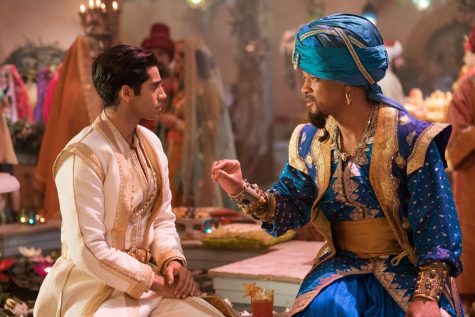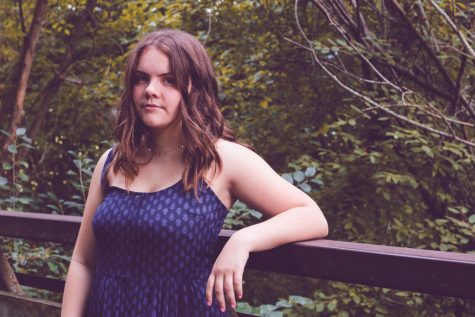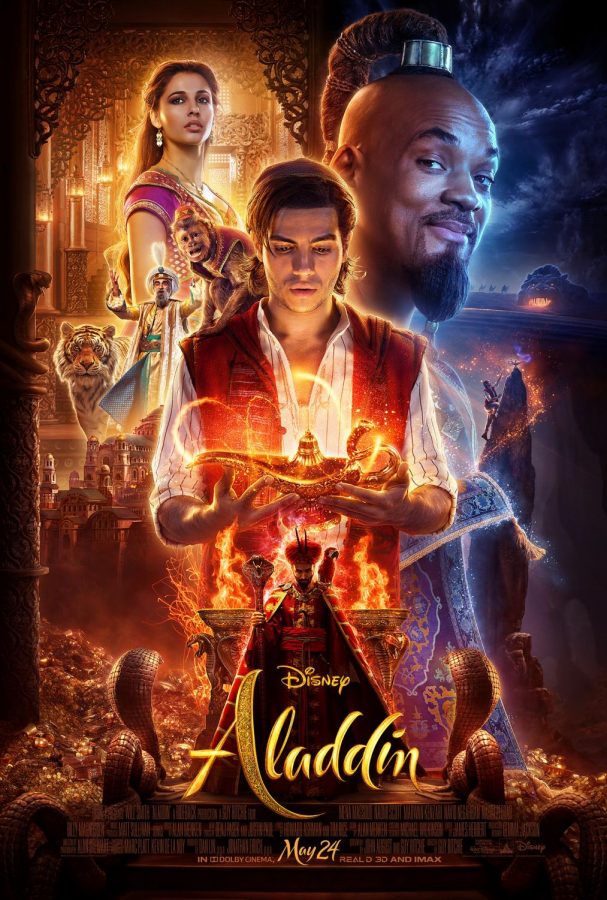The Aladdin remake was shining, shimmering, and splendid
Upon my original viewing of the first teaser trailer for Guy Ritchie’s live-action remake of Aladdin, I had to fight back metaphorical vomit at the reveal of the creepy, cerulean creature that was the CGI nightmare of a genie played by Will Smith.
I made a quick, easy judgment that the rest of the movie would be just as abhorrent and as ill of a comparison to the 1992 original.
As more promotion was released, my opinion began to shift; I wasn’t completely sold or anticipating a perfect film, but still, I made sure I had a ticket come opening weekend.
My “gut feelings” should soon be subject to consideration, for my premonitions of the movie could not have been more misplaced; the film was everything that the new wave of Disney remakes should strive for.
In the past, the largest problem that remakes have been faced with is the obvious stylistic differences between animation and live action. Animated originals have freedom and creativity of movement that is only limited by the imagination of the animators. Shots that are next to impossible for a live action film can be drawn with ease. This also allows for the use of animals and magic to fit more cohesively into the overall style of animated movies, as opposed to looking obviously out of place in live action.
This simple, yet crucial difference is what has made previous remakes look either too stiff, too clunky, or too forced in comparison to their animated counterparts. Aladdin broke out of this pattern. I attribute this to two key factors.
This first was the more than stellar choreography. The most salient example of this was during a party scene around the midpoint of the movie where genuine dancing took place. The dancing and the movement felt, at least to my uneducated eye, authentic to what is associated with Middle Eastern culture without being campy or cheesy. The ensemble dancers were immensely talented, but the leads, Mena Massoud and Naomi Scott (as Aladdin and Jasmine respectively), held their own amongst obviously trained professionals. It was breathtaking to watch, remarkably interesting, and fit into the context of the story rather than just being tacked on.
A second expert example of choreography could be attributed to Aladdin’s “street rat” like nature and knowledge of the kingdom. His rapid, skillful navigation and chases with the palace guards feel like the movie in terms of their fluidity and authenticity.
The overall use of movement throughout the film felt more akin to a theatrical stage production than a movie, which, in my opinion, translated beautifully from the animation to the final product that I saw.
The second aspect of the film that retained an “animated” like quality was the setting. The panning overhead shots of the fictional kingdom of Agrabah were breathtaking, magical, and enigmatic. From the ornate interiors of the palace to the busy and bustling street markets, the entire setting felt like it had that animated, Disney quality to it. The movie itself was shot in Jordan, and the scenes in the actual desert were just as jaw-dropping as those in the fictional city. The colors and lighting were bright and dizzying in just the right way.
As perfect as this scenery was, the actors who lived inside it were just as deserving of praise. All of them managed to stay true to the original depictions while still feeling fresh. Massoud’s portrayal of the titular character was a particular favorite of mine. The relatively obscure actor was so true to the Aladdin I grew up with. He had that boyish charm and specific smirk that made the entire audience fall just a little bit in love with him and unequivocally root for him in the end.

Scott’s Jasmine was a standout. For starters, the character itself was deepened. In the original, Jasmine’s main concern was that she was unable to marry a commoner and was forced to wed a prince. This is still a problem for 2019 Jasmine, but her end goal is not just abolishing this law, but becoming Sultan, a position she is blocked from because of her gender. This shift in motivation felt so natural and not just progressive for the sake of being politically correct in 2019; it felt very characteristic for the same spirit first conjured in the 1992 film. Scott handled this with entertaining grace and completely stole all the scenes she was in.
The only addition in terms of music was the song “Speechless,” a musical monologue where Jasmine expresses her refusal to remain silent about what she believes. It was a powerful moment that stuck in a good way and blended in perfectly with the already fantastic score.
The music was handled fantastically. All of everyone’s old favorites were back in their full glory, and there wasn’t a speck of autotune to be heard. The cast’s singing chops was tantamount to their wonderful acting.
While most of the songs were very similar to the animation, I noticed the biggest difference in the songs that featured the Genie. The sentiment could be said involving his entire character. Smith was who I was most nervous about, but he ended up being one of my favorite aspects of the movie. Robin William’s portrayal of the Genie was so fantastic that it has practically reached cult status in terms of its fanbase. Smith understood this, and his version was different. It was less stand up and more fresh prince.
Jafar’s character had also gone through some revamping. In the original, the guy was simply power hungry, but it felt as though he was evil simply for the sake of being evil. Marwan Kenzari’s approach was a bit more sinister. His background was more fleshed out, so the viewers could see how his ambition to rise politically had become corrupt. He was power hungry and had been ignored for years. Combined, those two aspects fueled Jafar to achieve his goals by any means possible. Additionally, his frequent patronizing and sexist remarks toward Jasmine made him not only all the more terrifying, but also all the more real.
The biggest difference between the two adaptations was the ending. I won’t spoil anything, but I will say that I found the animated one to be a bit more dramatic and cinematic, and served as an overall more satisfying climax to the story.
Watching this film couldn’t have been more of a right call. Its humor and spectacle make it a joy for those with varying degrees of love towards the original. Its heart and intelligence will make viewers want to watch again and again.

Meredith VanSkiver is a senior entering her final year on staff, which makes her bittersweet but still ready to work. In addition to The Central Trend, she...



























































































